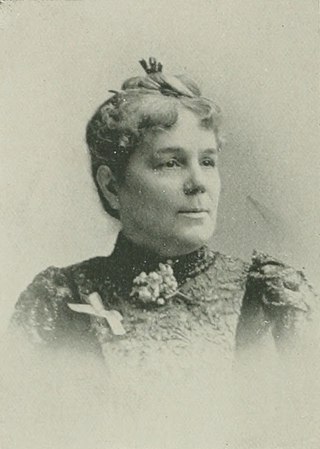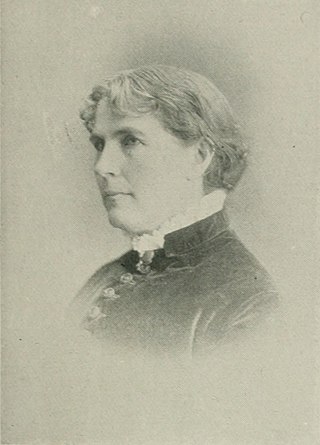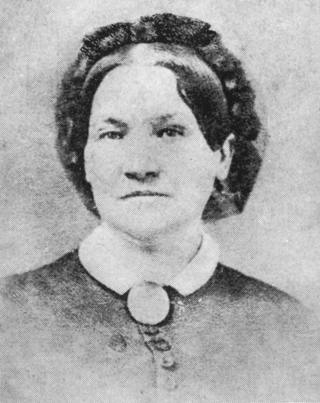
Augusta Jane Wilson, was an American author of Southern literature and a supporter of the Confederacy during the American Civil War. Her books were banned by the American Library Association in 1881. She was the first woman to earn US$100,000 through her writing.

Hannah Adams was an American author of books on comparative religion and early United States history. She was born in Medfield, Massachusetts and died in Brookline. Adams is believed to have been the first woman in the U.S. to work as a professional writer.
Anne Moncure Crane (Seemüller) was an American novelist, who wrote books such as Emily Chester,Opportunity and Reginald Archer., which were about female sexual desires. Her novels were considered controversial in some quarters of post-Civil War American society. The author Henry James was influenced by Crane's books. She was an important writer in early American realism.

Mary Elizabeth Hewitt was an American poet and editor who flourished in the 1840s and 1850s. She published: Memorial of F. S. Osgood; Songs of Our Lord; Heroines of History; and Poems Sacred, Passionate, and Legendary.

Abigail Goodrich Whittelsey was an American educator, magazine founder, and editor. In her publication, Mother's Magazine, she provided information and instructions on the role of mothers.

Hannah Elizabeth Bradbury Goodwin Talcott was an American novelist, poet and educator from Maine who resided in Boston for many years. She wrote under various pen names, including H. B., H. E. B., H. B. G., Mrs. H. B. Goodwin, and Mrs. Goodwin-Talcott.

Mary Towne Burt was a 19th-century American temperance reformer, newspaper publisher, and benefactor from Ohio. Burt was identified with temperance work nearly all her life. She was the first president of the Auburn, New York branch of the Women's Christian Temperance Union, and beginning in 1882, served as president of the New York State Society of the Union. In 1875, she became the publisher, and subsequently the editor, of Our Union, the organ of the society, and in 1878–80 was the corresponding secretary of the National Union. For several years, Burt had charge of the legislative interests of the union, and several laws for the protection of women and young girls resulted from her efforts.

Emma Augusta Sharkey was a 19th-century American writer, journalist, dime novelist, and story-teller from New York. Known as Mrs. E. Burke Collins in the literary world, she wrote for the press and was one of the small group of women writers of her era who earned more than US$6,000 a year with their writing. As with Sarah Elizabeth Forbush Downs, Sharkey used a married name as a pseudonym.

Aubertine Woodward Moore was an American musician, writer, musical critic, translator, and lecturer. She resided in Madison, Wisconsin, since 1877, and lectured extensively, especially on Norwegian literature and music. She gave piano recitals and concerts in Boston, Philadelphia, and New York City. Moore was a founder of the Wisconsin Conservatory of Music.

Mary Elizabeth Sherwood was an American author and socialite. She wrote short stories, poetry, several books, and etiquette manuals, in addition to contributing to many magazines and translating poems from European languages. Among her writings are The Sarcasm of Destiny, A Transplanted Rose, Manners and Social Usages, Sweet Briar, and Roxobel. Better known as Mrs. John Sherwood, some of her literary works were published as "M.E.W.S." or "M.E.W. Sherwood".

Helen Ekin Starrett was an American educator, author, suffragist, and magazine founder. Long engaged in educational work in Chicago, she founded the Kenwood Institute (1884), and Mrs. Starrett's Classical School for Girls (1893), of which she was principal. Starrett also founded Western Magazine. She served as president of the Illinois Woman's Press Association (1893–1894), and was the author of several works.

Frances Laughton Mace was an American poet. Her poems first appeared in The Journal of Commerce. She was best remembered for the poem and hymn "Only Waiting", written when she was 18, and published in the Waterville Mail. Its authorship, for a time, was confused. The work was included in her volume Legends, Lyrics, and Sonnets. Her later work was included in Under Pine and Palm (1888) and Wild Roses of Maine (1896). Mace died in 1899.
Frances Elizabeth Barrow was a 19th-century American children's writer.

Rosa Miller Avery née, Miller; was an American abolitionist, political reformer, second-generation suffragist, and writer.
Nelly Marshall was a 19th-century American "southland" author of novels and verse. In her day, Marshall was perhaps one of the most popular writers in the Southern and Western United States. In her first ten years of writing, she may have written more than any woman of her age in the United States. In addition to numerous poems and magazine articles, she published two volumes of verse, entitled A Bunch of Violets, and Leaves From the Book of My Heart. Her novels included Eleanor Morton, or Life in Dixie (1865); Sodom Apples (1866); Fireside Gleamings (1866); Dead Under the Roses (1867); Wearing the Cross (1868); As by Fire (1869); Passion, or Bartered and Sold (1876); and A Criminal Through Love (1882).

Maria T. Daviess was a 19th-century American author of Kentucky. Among her publications were Roger Sherman, a Tale of '76; Woman's Love; a volume of Poems; and History of Mercer and Boyle Counties.

Emma Howard Wight was an American author and newspaper correspondent. After leaving school, she wrote occasionally for amusement. Her friend, Bertha von Hillern, induced Wight to start publishing her work. Articles by Wight appeared in various papers and were extensively copied. Her numerous theological articles attracted wide attention. She also wrote serial novels. Among her works can be counted Passion Flowers and the Cross. A novel (1891), The Soul of Edmund Jaffray, an emotionalism in 1 act (1892), My Husband (1893), A Loveless Marriage (1894), The Little Maid of Israel (1900), The Berkleys (1900), and Like No Other Love (1910).

Euphemia Johnson Richmond was an American litterateur and author of novels and children's literature. Her early sketches, published in periodicals, were under the pen name, "Effie Johnson", but her later work was under her own name styled as "Mrs. E. J. Richmond".

Emma Wolf was an American litterateur and novelist. She published early in life and was the author of five novels. Wolf was born with a congenital defect and spent part of her life in a wheelchair.

Mary Ann Mann Cornelius was an American author and social reformer. A temperance activist, she served as president of the Woman's Christian Temperance Union (W.C.T.U.) of Arkansas. She lived several years in Tacoma, Washington, where she established a free reading room and circulating library for the young. In Tacoma and also in Topeka, Kansas, Cornelius served as a director of the humane society. She was the author of various novels and occult stories, including Little Wolf; Uncle Nathan's Farm; The White Flame; and Why? or A Kansas Girl's Query. She favored woman's suffrage.

















